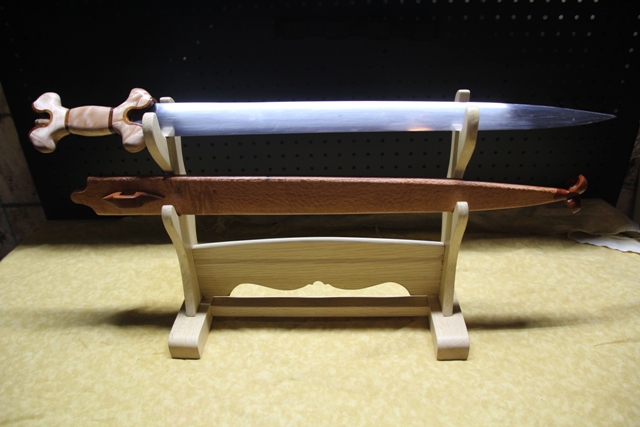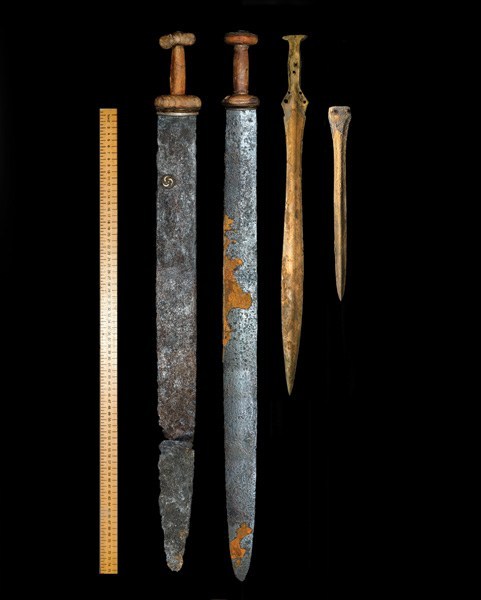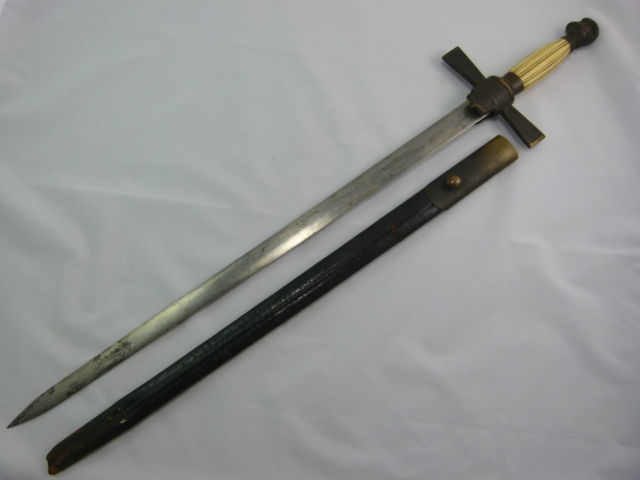| Author |
Message |
Martin Kallander

|
 Posted: Sat 31 Oct, 2020 3:21 pm Post subject: Show me your lenticular swords Posted: Sat 31 Oct, 2020 3:21 pm Post subject: Show me your lenticular swords |
 |
|
|
I have goten interested in swords with lenticular blades that are clean (ie, no fuller or ridge or something) But I have had a really hard time finding images of swords like these. So please show off your lenticular swords for me, or images you found online, anything will do
|
|
  |
 |
|
Matthew Amt
|
 Posted: Sat 31 Oct, 2020 4:03 pm Post subject: Posted: Sat 31 Oct, 2020 4:03 pm Post subject: |
 |
|
My Greek hoplite sword? Well, one of them, with a handy photo.

Matthew
|
|
   |
 |
J. Nicolaysen

|
 Posted: Tue 10 Nov, 2020 5:33 pm Post subject: Posted: Tue 10 Nov, 2020 5:33 pm Post subject: |
 |
|
Here's my lenticular bladed La Tene, by Brian Kerce
 Attachment: 124.02 KB Attachment: 124.02 KB

|
|
  |
 |
Nathan Robinson
myArmoury Admin


|
|
    |
 |
Martin Kallander

|
|
  |
 |
Paul Hansen

|
 Posted: Thu 12 Nov, 2020 9:21 am Post subject: Posted: Thu 12 Nov, 2020 9:21 am Post subject: |
 |
|
My bet would be that those are fakes...
|
|
  |
 |
|
Jeremy V. Krause
|
 Posted: Thu 12 Nov, 2020 10:54 am Post subject: Posted: Thu 12 Nov, 2020 10:54 am Post subject: |
 |
|
|
I also question the authenticity of the lenticular viking sword shown. It has the strange raised inlay that is seen on other fakes.
|
|
  |
 |
Nathan Robinson
myArmoury Admin


|
|
    |
 |
|
Spenser T.
|
 Posted: Thu 12 Nov, 2020 1:21 pm Post subject: Posted: Thu 12 Nov, 2020 1:21 pm Post subject: |
 |
|
Here's some lenticular British Iron Age swords...
The Scottish sword does have a fuller, but come on, the blade past the fuller is beautifully lenticular.
 Attachment: 33.78 KB Attachment: 33.78 KB

 Attachment: 112.92 KB Attachment: 112.92 KB
[ Download ]
|
|
  |
 |
Martin Kallander

|
 Posted: Thu 12 Nov, 2020 2:24 pm Post subject: Posted: Thu 12 Nov, 2020 2:24 pm Post subject: |
 |
|
Yes, I have been on this forum long enough to know you all despise those inlays like cats despise dogs. Like I said, I am looking for lenticular swords primarily and regardless of whether or not the viking sword is real, I doubt you'd contest the shape of it.
Having said that, I do think there is reason to not outright dismiss this particular one. Because it is a 10th century sword and because of the overall length. I'm sure many of you have read the Sylloge Tacticorum which stipulate roman infantry swords are supposed to be four spans long including the hilt. While Timothy and others think a span being 23.4 cm is unreasonable, I think they base this on poor grounds and so assuming a span is roughly 23.4 cm, this sword is just about exactly the right length of a roman infantry sword of this period (94 cm). Although I would point out saying the varangian guard mainly fought on foot is an assertion without definite evidence, if there were a sizable proportion of them who did then all the criteria for a sword like this to exist are met, wealthy infantrymen who would be required to carry swords with these dimensions and who would want hilts like these. As for the raised inlays, you should not rule out those could have been added at a later time to increase the sword's value on the antique market.
So yea, not exactly firm grounds, but the case can definitely be made and it should not be dismissed outright.
|
|
  |
 |
|
Michael Beeching
|
 Posted: Thu 12 Nov, 2020 2:37 pm Post subject: Posted: Thu 12 Nov, 2020 2:37 pm Post subject: |
 |
|
Martin,
I don't want you to have to seek out a book you don't have, but if you have access to DKM's "The Sword: Form and Thought," there should be several examples of lenticular swords in there.
...I bring this up, as a project of mine was to see if I could re-create one of the swords in the catalog to see if I could match its weight and balance. I cannot recall the sword's number in the catalog, but it is a lenticular "bastard sword" of really impressive size. The thing must have been primarily intended for use from horseback, and is otherwise "stereotypically Teutonic": it's huge! I don't think it would be appropriate to make a copy of the catalog entry, but I can show you the unfinished project when I get a chance. I'll give you numbers at that time as well.
|
|
  |
 |
Martin Kallander

|
 Posted: Thu 12 Nov, 2020 2:55 pm Post subject: Posted: Thu 12 Nov, 2020 2:55 pm Post subject: |
 |
|
|
Very good, I will procure this book as soon as possible. In the mean I would be very interested in this project of yours
|
|
  |
 |
|
Michael Beeching
|
 Posted: Thu 12 Nov, 2020 3:40 pm Post subject: Posted: Thu 12 Nov, 2020 3:40 pm Post subject: |
 |
|
Martin,
If you are intent on getting the book, note that there are in fact two books with the same name. One is an illustrated museum catalog, and another is a collection of academic articles.
...As an example, this is the book I'm referencing - it is a softcover (albeit a tough softcover) of relatively square proportions:
https://www.woodenswords.com/The_Sword_Form_and_Thought_p/book-sch01.htm
I will attempt to look through it tonight and see what other entries are present in there which would be of interest to you.
|
|
  |
 |
|
Michael Beeching
|
 Posted: Thu 12 Nov, 2020 10:45 pm Post subject: Posted: Thu 12 Nov, 2020 10:45 pm Post subject: |
 |
|
Here are the notable examples in The Sword: Form and Thought:
Exhibit 3: An executioner's sword: this is a two-handed weapon just over a meter long, designed to be used in two hands. A short fuller is present in the blade near the hilt.
Exhibit 19: This is the sword I am replicating to see if I can get the weight and balance correct. Over 1.2 meters long with a blade over 1 meter long itself, this is a purely lenticularly-bladed weapon. All the while, the museum exhibit weighs in at only 1.5kg, I will get pictures of my project this weekend.
...That said, I do now wonder if I overestimated the number of lenticular-bladed swords in the book; please forgive me, I did not have it when I made my previous remarks. However, I still would recommend the catalog to anyone! Note that there are other lenticular weapons, though they have substantial fullers.
|
|
  |
 |
Martin Kallander

|
 Posted: Fri 13 Nov, 2020 2:29 am Post subject: Posted: Fri 13 Nov, 2020 2:29 am Post subject: |
 |
|
|
Well, buying a book for two images seems a bit unreasonable, especially when the swords in question are outliers like the short swords only in the other direction
|
|
  |
 |
Paul Hansen

|
 Posted: Sun 15 Nov, 2020 8:32 am Post subject: Posted: Sun 15 Nov, 2020 8:32 am Post subject: |
 |
|
| Martin Kallander wrote: | | Well, buying a book for two images seems a bit unreasonable, especially when the swords in question are outliers like the short swords only in the other direction |
If you can afford it, buy the book while it's still available.
I've probably learned more from that book than from any other book about swords.
Granted, a lot of the information about sword design and engineering can also be found in the posts from Peter Johnsson and Vincent Chevallier here on the forum, but the book presents it in a logical format, demonstrates it with relevant examples and expands on the concepts in a few other directions.
Really excellent work and I can't recommend it enough.
| Martin Kallander wrote: | | Like I said, I am looking for lenticular swords primarily and regardless of whether or not the viking sword is real, I doubt you'd contest the shape of it. |
Hmm, I think the vast majority of double edged Viking swords (where the blade is sufficiently preserved) has a fuller.
Maybe a few early examples (rather, likely late Migration age examples) have a Geibig Type 1 blade without fuller.
https://myArmoury.com/feature_geibig.html
|
|
  |
 |
|
Michael Beeching
|
 Posted: Sun 15 Nov, 2020 6:57 pm Post subject: Posted: Sun 15 Nov, 2020 6:57 pm Post subject: |
 |
|
I was hoping to get a better image (with me in it!) for scale, but the results just weren't going to cut it. So, I used the floor and a tape measure instead (the qama also helps). This unfinished sword blank is again Exhibit #19 from The Sword: Form and Thought. Once finished, this should weigh in at 3.3 to 3.5lb (with the fixtures) all the while measuring in at 50" overall. It's huge.

|
|
  |
 |
Glen A Cleeton

|
 Posted: Mon 16 Nov, 2020 8:20 am Post subject: Posted: Mon 16 Nov, 2020 8:20 am Post subject: |
 |
|
19th century
An Ames m1832 (copy of the French 1816) and an early Ames 1840s militia sword
Cheers
GC
 Attachment: 21.99 KB Attachment: 21.99 KB

 Attachment: 301.14 KB Attachment: 301.14 KB
[ Download ]
|
|
  |
 |
Martin Kallander

|
 Posted: Mon 16 Nov, 2020 11:07 am Post subject: Posted: Mon 16 Nov, 2020 11:07 am Post subject: |
 |
|
| Glen A Cleeton wrote: | 19th century
An Ames m1832 (copy of the French 1816) and an early Ames 1840s militia sword
Cheers
GC |
Thank you, The first one is a very nice blade! I think something went wrong because the second image is a dagger with a fuller (although that is an interesting and unusual thing in and of itself)
|
|
  |
 |
Martin Kallander

|
 Posted: Mon 16 Nov, 2020 11:08 am Post subject: Posted: Mon 16 Nov, 2020 11:08 am Post subject: |
 |
|
| Michael Beeching wrote: | I was hoping to get a better image (with me in it!) for scale, but the results just weren't going to cut it. So, I used the floor and a tape measure instead (the qama also helps). This unfinished sword blank is again Exhibit #19 from The Sword: Form and Thought. Once finished, this should weigh in at 3.3 to 3.5lb (with the fixtures) all the while measuring in at 50" overall. It's huge.
 |
Nice so far, looking forward to the finished thing!
|
|
  |
 |
|
|

